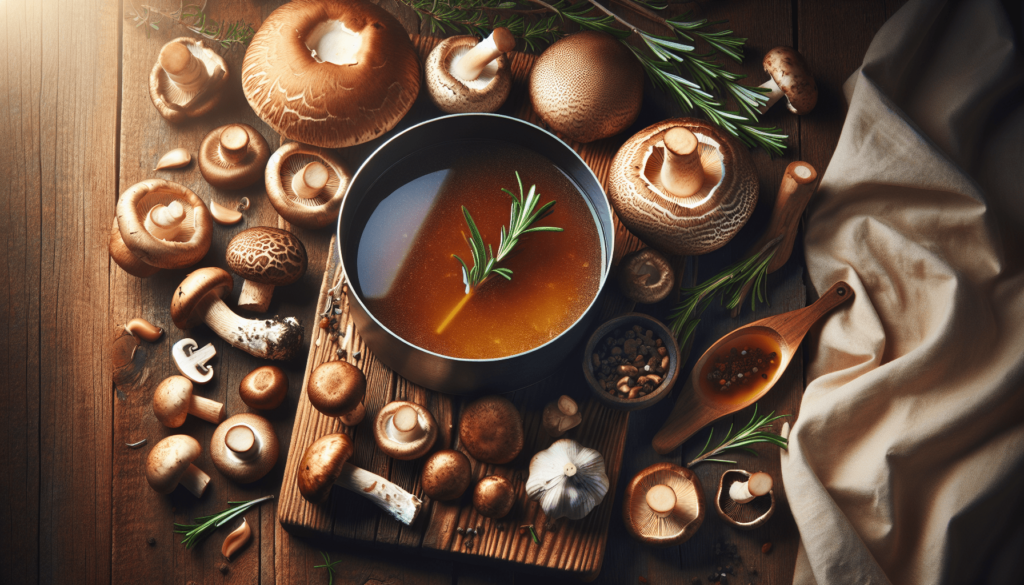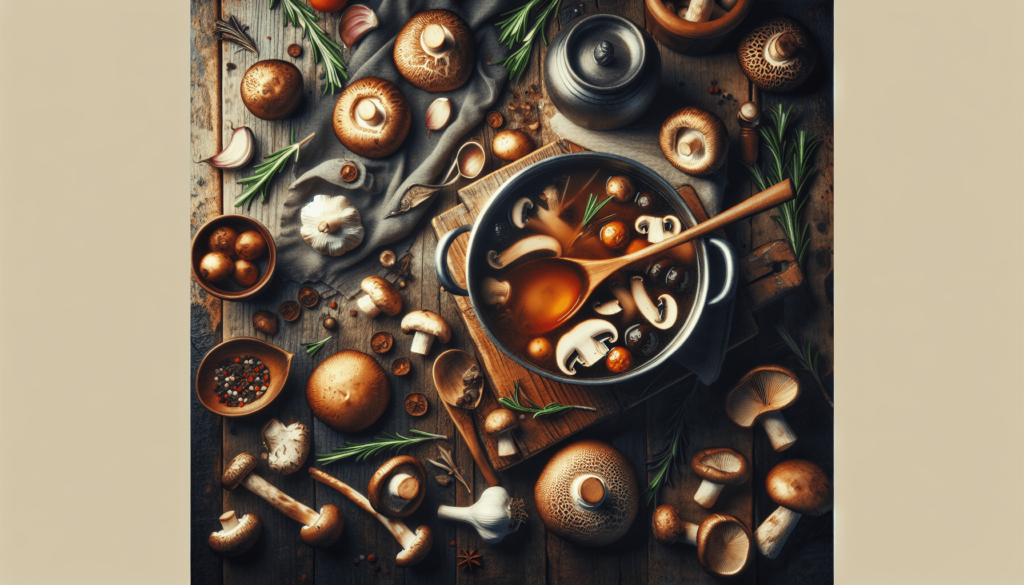Mushroom Broths and Stocks: The Foundation of Flavorful Cooking” opens the door to a world where the humble mushroom transforms your everyday dishes into gourmet masterpieces. You’ll discover how mushroom broths and stocks, rich with umami, form the backbone of countless recipes, from comforting soups to refined sauces. Detailed guides will walk you through selecting the right mushrooms, mastering the preparation techniques, and exploring innovative uses that promise to elevate your culinary game. With practical tips, creative ideas, and a sprinkle of scientific insight, this article promises to be your trusty companion in crafting flavorful, mushroom-infused meals that delight the senses and nurture the soul. Have you ever wondered why some dishes have that deeply satisfying, almost mystical depth of flavor that you just can’t quite put your finger on? The secret often lies in the foundation — the broth or stock. And when mushrooms come into play, you can elevate your culinary creations from ordinary to extraordinary.
Mushroom Broths and Stocks: The Foundation of Flavorful Cooking
Cooking isn’t just about following recipes; it’s about understanding the ingredients, the techniques, and the subtle ways to coax out the very best flavors. Mushroom broths and stocks are the silent heroes in the kitchen, providing a robust umami base that can transform soups, sauces, risottos, and much more.

Understanding Mushroom Varieties
Before diving into broth and stock preparation, it’s essential to familiarize yourself with the different types of mushrooms and their unique characteristics. This knowledge will help you choose the right mushrooms for your specific culinary needs.
Common Mushroom Varieties and Their Flavors
| Mushroom Type | Flavor Profile | Best Uses |
|---|---|---|
| Button Mushrooms | Mild and earthy | Soups, stews, basic stock |
| Shiitake Mushrooms | Rich, smoky, umami | Dashi, Asian broths, enhancing gravies |
| Portobello | Meaty and robust | Grilling, hearty broths, vegetarian substitutes |
| Morels | Nutty, earthy, and rich | Gourmet stocks, sauces, luxurious dishes |
| Chanterelles | Fruity and peppery | Delicate broths, creamy sauces |
| Porcini | Deeply earthy, umami | Risottos, powerful stocks, Italian cuisine |
| Oyster Mushrooms | Mild and slightly sweet | Light broths, vegetarian dishes |
| Truffles | Intensely aromatic | Infusing oils, enhancing luxury dishes |
The Science of Umami
Mushrooms are rich in umami, the fifth taste, which is often described as savory or meaty. The umami compounds in mushrooms, such as glutamates, work synergistically to deepen the flavor profile of any dish. When used in broths and stocks, these compounds can magnify the taste of even the simplest ingredients.
Benefits of Using Mushroom Broths and Stocks
Using mushroom broths and stocks offers several benefits beyond taste.
Nutritional Advantages
Mushrooms are packed with essential vitamins and minerals, including B-vitamins, selenium, and antioxidants. Using mushroom-based broths can add a nutritional boost to your meals.
Vegetarian and Vegan Options
For those following plant-based diets, mushrooms serve as an excellent meat alternative. Mushroom stocks can impart a deep, satisfying flavor normally achieved through meat-based broths.
Making Basic Mushroom Stock
Creating a basic mushroom stock is straightforward and can become the cornerstone of your culinary repertoire.
Ingredients
- 1 lb of mixed mushrooms (button, shiitake, and portobello work well)
- 1 large onion, chopped
- 2 cloves of garlic, minced
- 2 carrots, chopped
- 2 celery stalks, chopped
- 8 cups of water
- 2 bay leaves
- 1 tsp black peppercorns
- Salt to taste
- Optional: herbs like thyme or parsley
Procedure
- Prep the Ingredients: Chop all vegetables and mushrooms into small, uniform pieces.
- Sauté: In a large pot, sauté onions, garlic, carrots, and celery until soft.
- Add Mushrooms: Add the chopped mushrooms and continue to sauté until they begin to brown.
- Simmer: Add water, bay leaves, peppercorns, and optional herbs. Bring to a boil, then reduce to a gentle simmer.
- Cook: Let the stock simmer for about an hour, allowing the flavors to meld together.
- Strain: Strain the stock through a fine mesh sieve, discarding solids. Season with salt as needed.
Advanced Techniques for Mushroom Stock
For an even richer, more complex mushroom stock, consider the following techniques.
Roasting the Mushrooms
Roasting the mushrooms before adding them to your stock can intensify their flavors. Spread chopped mushrooms on a baking sheet, drizzle with olive oil, and roast at 400°F (200°C) for 20-25 minutes before adding them to your stockpot.
Adding Dried Mushrooms
Dried mushrooms, such as porcini or morels, have concentrated flavors. Rehydrate them in hot water before adding both the mushrooms and their soaking liquid to your stock. This extra step can significantly enhance the depth of your stock.
Using Wine or Vinegar
A splash of white wine or a tablespoon of apple cider vinegar can add acidity to your stock, balancing the flavors and drawing out more complexity from the mushrooms.
Creative Uses for Mushroom Broth and Stock
Once you have your luscious mushroom stock, the culinary possibilities are endless. Here are some delicious ways to use it.
Risotto
Mushroom stock is a game-changer in risotto, adding depth and richness that water or regular vegetable stock just can’t match.
- Sauté: Sauté onions and garlic in a pan with olive oil.
- Add Rice: Add arborio rice and toast it slightly.
- Ladle Stock: Slowly add mushroom stock, one ladle at a time, stirring continuously until the rice is creamy and al dente.
- Finish: Stir in some sautéed mushrooms and a handful of freshly grated Parmesan.
Soups
Elevate your favorite soup recipes with mushroom stock.
- French Onion Soup: Replace beef broth with mushroom stock for a vegetarian version.
- Miso Soup: Use mushroom broth as the base for an even richer taste.
- Cream of Mushroom Soup: Use your homemade mushroom stock to highlight the earthy flavors of the mushrooms.
Sauces and Gravies
A good sauce or gravy can be the crowning jewel of any meal, and using mushroom stock can make all the difference.
Mushroom and Thyme Gravy
- Ingredients: 2 cups mushroom stock, 1 cup sliced mushrooms, 1 tbsp butter, 1 tbsp flour, fresh thyme, salt, and pepper.
- Procedure:
- Sauté the sliced mushrooms in butter until they are golden brown.
- Sprinkle the flour over the mushrooms and stir to make a roux.
- Gradually add the mushroom stock, stirring constantly to avoid lumps.
- Add fresh thyme, salt, and pepper. Simmer until the gravy thickens.

Incorporating Medicinal Mushrooms
Medicinal mushrooms, such as reishi, chaga, and lion’s mane, can add health benefits to your stocks and broths. These mushrooms are renowned for their immune-boosting and anti-inflammatory properties.
Reishi Mushroom Broth
Reishi mushrooms are known for their bitter taste but offer incredible health benefits. This broth is perfect for sipping or using as a base for soups.
- Ingredients: 1 reishi mushroom, 10 cups water, 3 slices of ginger, 1 onion, salt to taste.
- Procedure:
- Combine all the ingredients in a large pot.
- Bring to a boil, then let it simmer for two to three hours.
- Strain and season as necessary.
Preserving Mushroom Broth
If you’ve made a large batch of mushroom broth, preserving it for future use is a great idea.
Freezing
Pour cooled broth into ice cube trays. Once frozen, transfer the cubes into a zip-lock bag for easy, portion-sized use.
Canning
Canning is another preservation method that allows you to store mushroom broth for an extended period.
- Preparation: Sterilize canning jars and prepare a pressure canner.
- Fill Jars: Ladle hot mushroom stock into jars, leaving an inch of headspace.
- Process: Follow the guidelines for your pressure canner, processing for the appropriate time at the correct pressure.
Foraging for Mushrooms
Foraging for mushrooms can be a rewarding experience, but it’s crucial to follow ethical and safe practices.
Ethical Foraging Guidelines
- Identify Properly: Always correctly identify mushrooms before picking. Misidentification can lead to serious health risks.
- Take Only What You Need: Over-harvesting can harm the ecosystem.
- Use a Knife: Cut mushrooms at the base rather than pulling them out to avoid damaging the mycelium.
Growing Your Own Mushrooms
If foraging isn’t your thing, why not try growing your own? It’s easier than you might think.
Home Cultivation Tips
- Choose the Right Kit: Many companies offer kits for growing mushrooms like oyster or shiitake.
- Monitor Conditions: Keep the growing medium in a cool, dark place and ensure it remains moist.
- Harvest at the Right Time: Mushrooms grow quickly; harvest them when they reach the ideal size.
Seasonal and International Recipes
Mushroom broths and stocks lend themselves beautifully to a myriad of recipes from different cuisines and seasons.
Winter: Wild Mushroom and Barley Stew
- Ingredients: Wild mushrooms, barley, carrots, celery, onions, garlic, mushroom stock, fresh herbs.
- Procedure:
- Sauté onions, garlic, carrots, and celery.
- Add wild mushrooms and cook for a few minutes.
- Stir in barley, then pour in mushroom stock.
- Simmer until barley and vegetables are tender. Add fresh herbs before serving.
Summer: Chilled Mushroom and Cucumber Soup
- Ingredients: Cucumbers, mushrooms, garlic, yogurt, lemon zest, dill, mushroom stock.
- Procedure:
- Blend cucumbers and mushrooms with yogurt and garlic.
- Add chilled mushroom stock and lemon zest.
- Garnish with dill and serve cold.
International: Japanese Mushroom Dashi
- Ingredients: Kombu, dried shiitake mushrooms, water.
- Procedure:
- Soak kombu in water for 30 minutes, then bring to a simmer.
- Remove kombu and add dried shiitake mushrooms.
- Simmer gently for another 20 minutes before straining.
Sustainability and Community
Mushroom cultivation and foraging can also contribute to sustainable living practices.
Sustainable Practices
- Use Organic Materials: Always opt for organic substrates when growing mushrooms.
- Support Local Foragers: Buy from local foragers and growers to support sustainable practices.
Conclusion
Mushroom broths and stocks are more than just a liquid base; they are a gateway to deeper, richer flavors and nutritious meals. Whether you’re a novice cook or a seasoned chef, incorporating mushroom stocks into your kitchen arsenal offers endless culinary possibilities. From risottos to soups to international dishes, the humble mushroom can truly transform your cooking. So, go ahead—experiment, savor, and let mushrooms be the foundation of your next flavorful creation.
